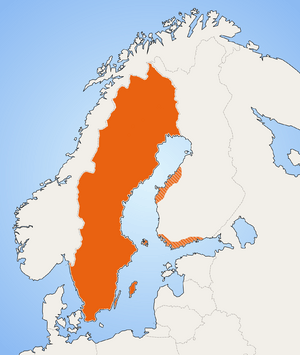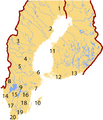Swedish language facts for kids
Quick facts for kids Swedish |
||||
|---|---|---|---|---|
| svenska | ||||
| Native to | Sweden, Finland | |||
| Native speakers | 11.1 million (2017) | |||
| Language family |
Indo-European
|
|||
| Early forms: |
Old Swedish
|
|||
| Writing system | Latin (Swedish alphabet) Swedish Braille |
|||
| Official status | ||||
| Official language in | Nordic Council |
|||
| Regulated by | Swedish Language Council (in Sweden) Swedish Academy (in Sweden) Research Institute for the Languages of Finland (in Finland) |
|||
| Linguasphere | 52-AAA-ck to -cw | |||

Major Swedish-speaking areas
|
||||
|
||||
Swedish is a language mostly spoken in Sweden and in parts of Finland, typically along the southern and western coasts and on the Åland islands. More than nine million people speak Swedish. It is similar to two of the other Scandinavian languages, Norwegian and Danish, and a person who understands one of these languages can understand the others. Other Scandinavian languages, such as Icelandic and Faroese, are less closely related and cannot be understood by Swedish speakers. Standard Swedish is spoken and written throughout Sweden, but there are some local dialects with differences in grammar and vocabulary in small towns and rural areas.
Swedish began as a dialect of Old Norse, which was a language that everyone in Scandinavia understood during the Viking Age. Around the 12th century Swedish began to slowly become different from the other dialects. These dialects later became what we today call Norwegian, Icelandic, Faroese and Danish. Swedish is a Germanic language with some similarities to English because of the Vikings that invaded England in the 10th Century. It is even more similar to German and Dutch, partly because of the Hanseatic League of the Middle Ages, when Sweden traded very openly with Germany.
There are three characters in the Swedish language that are not used in English. These are å, ä and ö. The letter å is a vowel sound between [a] and [o], similar to the English word awe. The letter ä is a vowel sound similar to [ɛ], like in the English word bed. The letter ö is a vowel sound between [o] and [ɛ], pronounced [øː] like the u in the English word burn. These characters are also used in the Finnish language, while Norwegian and Danish languages replace ä and ö with similar characters æ and ø.
Swedish also has some important differences in grammar. Definite articles are suffixed onto the end of their nouns, so ett hus (a house) becomes huset (the house). Also unlike English, Swedish uses two grammatical genders called Common and Neuter. Nouns of the Common gender are sometimes called "en words", and many words for living (or once-living) things are "en words". Nouns of the Neuter gender are sometimes called "ett words".
Example of some words in Swedish
| Swedish | English |
|---|---|
| Ett/En | One |
| Två | Two |
| Tre | Three |
| Fyra | Four |
| Fem | Five |
| Sex | Six |
| Sju | Seven |
| Åtta | Eight |
| Nio | Nine |
| Tio | Ten |
| Ja | Yes |
| Nej | No |
| Jag | I |
| Du | You |
| Mig | Me |
| Han | He |
| Hon | She |
| Vi | We |
| De/dem | They/them |
| Jag är | I am |
| Sverige | Sweden |
| Hus | House |
| Hem | Home |
| Väg | Way |
| Björnar | Bears |
| Hjälp | Help |
Basic Swedish Expressions
| God dag/Hej | Good day/Hello |
| Hur mår du? | How are you? |
| Jag mår bra, tack | Very good, thank you |
| Tack | Thank you |
| Tack så mycket | Thank you very much |
| God morgon | Good morning |
| God eftermiddag | Good evening |
| Hej då | Goodbye |
Images for kids
-
Front page of Gustav Vasa's Bible from 1541, using Fraktur. The title translated to English reads: "The Bible / That is / The Holy Scripture / in Swedish. Printed in Uppsala. 1541".
-
August Strindberg, one of the most influential writers in modern Swedish literature.
See also
 In Spanish: Idioma sueco para niños
In Spanish: Idioma sueco para niños







